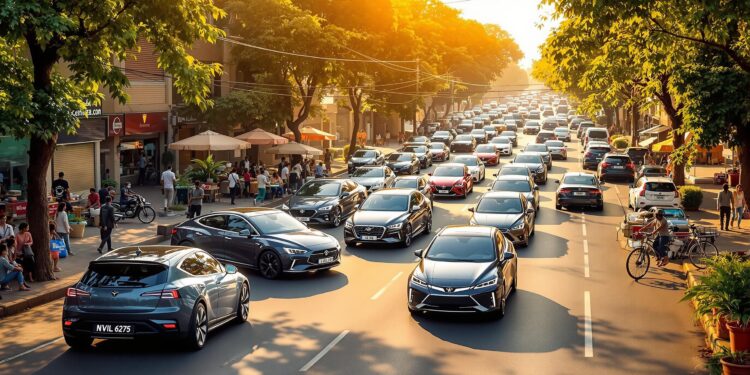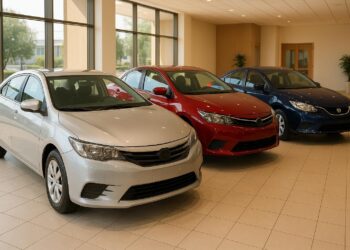Nairobi’s car market in 2025 is shaped by import taxes, government policies, and growing interest in electric vehicles. Here’s what you need to know:
- Taxes and Fees: Import Duty (25%), VAT (16%), Import Declaration Fee (3.5%), and Railway Development Levy (2%) significantly increase car prices. Excise duties (10–35%) vary by engine size and fuel type.
- Used Cars: Imports are limited to vehicles less than 8 years old, with strict compliance standards. Popular options include the Toyota Vitz ($4,990) and Mazda CX-5 ($19,800).
- Electric Vehicles (EVs): EVs are gaining traction, supported by tax incentives and Kenya’s renewable energy surplus. However, higher upfront costs remain a barrier.
- New Cars: Local assembly efforts aim to lower prices, but new vehicles are still pricier than used imports.
Quick Comparison Table
| Vehicle Type | Price Range | Key Features |
|---|---|---|
| Used Cars | $3,000–$88,500 | Affordable, wide variety, higher maintenance |
| New Cars | Higher than used | Latest tech, warranties, higher initial cost |
| Electric Cars | TBD (varied) | Lower running costs, eco-friendly options |
For budget buyers, used cars offer the best value. If you’re eco-conscious, EVs are worth exploring. New cars provide modern features but come at a premium.
EXTREMELY Cheap Cars and Prices in Nairobi Kenya 🇰🇪 2024
1. New Vehicles
Nairobi’s new vehicle market in 2025 is shifting as domestic assembly efforts influence pricing and complicate buying decisions. Here’s a closer look at the factors shaping new vehicle prices in Nairobi.
Current Market Dynamics
New vehicle prices are influenced by a mix of import duties, local assembly incentives, VAT, currency fluctuations, and production costs. While local assembly could lead to lower prices in the future, for now, new cars are typically more expensive than used imports.
These factors have prompted recent policy changes aimed at balancing the market.
Policy Changes and Market Effects
The government adjusted its plan to phase out used imports, introducing an 8-year age limit instead. This approach supports local production while addressing market needs.
"Implement a total ban on importation of used fully built units of commercial vehicles, and a phased out plan on importation of used FBU passenger vehicles. This will reduce the importation of used vehicles in the Kenyan market while facilitating the local manufacturers to assemble, and manufacture affordable vehicles for diverse domestic market segments." – Draft of National Automotive Policy
Consumer Impact
For Nairobi’s growing middle class, high new vehicle prices remain a hurdle. Despite policies favoring local manufacturing, many buyers still prefer used imports due to cost concerns. The relaxed import restrictions reflect these affordability challenges and the current market landscape.
2. Used Vehicles
Nairobi’s thriving used-car market offers affordable choices in 2025. Just as policies have influenced new car prices, similar regulations are shaping the used car market.
Market Price Overview
Compact cars like the 2010 Toyota Vitz are priced at about $4,990, while a 2009 Honda Fit averages $6,400. For families, larger vehicles like the 2015 Mazda CX-5 are available for around $19,800, reflecting the strong demand for SUVs. Here’s a quick look at current prices for popular models:
| Vehicle Category | Model Example | Year | Price (USD) |
|---|---|---|---|
| Economy Cars | Toyota Vitz | 2010 | $4,990 |
| Compact SUVs | Nissan Dualis | 2008 | $7,800 |
| Mid-size Sedans | Toyota Axio | 2010 | $9,200 |
| Premium SUVs | Subaru Forester | 2017 | $31,500 |
| Luxury Vehicles | Range Rover Evoque | 2016 | $88,500 |
This pricing showcases a wide variety of options across different segments.
Market Influences
Changes in import regulations continue to shape the availability and pricing of used vehicles, with recent proposals playing a key role in market trends.
Budget-Friendly Options
For buyers on a budget, reliable choices include the 2005 Mazda Demio at $3,950 or the 2011 Nissan March for $4,500. Business owners often turn to durable commercial vehicles like the 2020 Toyota Hiace, priced at $23,000, which also holds strong resale value.
Premium Segment
While budget-friendly cars cater to most urban buyers, the premium market offers some attractive deals too. For instance, the 2014 Land Rover Range Rover Vogue, priced at approximately $71,000, combines luxury with savings. This segment reflects the growing middle class, for whom used vehicles provide a more accessible alternative to new cars.
sbb-itb-e5ed0ed
3. Electric Cars
Electric vehicles (EVs) are becoming more popular in Nairobi as buyers look for alternatives to conventional cars. This shift is driven by updated government policies and private sector efforts. By 2025, Kenya aims for EVs to make up 5% of all vehicle imports – around 16,000 EVs annually. This growth is supported by the country’s surplus renewable energy supply (2,700 MW vs. 1,860 MW demand). While the market evolves, higher costs for both new and used vehicles remain a challenge.
Although specific price ranges for EVs in Nairobi are still being determined, experts anticipate a variety of options to suit different budgets and preferences.
Local Innovation and Infrastructure
Nairobi is emerging as a center for electric mobility advancements. Companies like BasiGo, Kiri, and Opibus are leading efforts in EV development and assembly. The city is also home to more than six two-wheeler assembly plants, several charging infrastructure providers, and various financing solutions tailored for EV adoption.
Cost Factors
Several elements affect EV pricing in Nairobi. Kenya’s energy grid, with about 90% of electricity sourced from renewables, offers a reliable base for EV use. However, inefficiencies in electricity transmission lead to higher energy costs, impacting overall operating expenses. On the bright side, tax incentives and government policies are helping reduce EV prices.
Two-Wheeler Market
Two-wheelers play a major role in Kenya’s EV market, making up nearly half of the country’s electric vehicles. A McKinsey study predicts that by 2040, electric two-wheelers could dominate, accounting for 60–75% of the market. This growth opens up fresh investment opportunities in Nairobi’s EV landscape.
Investment Opportunities
Key areas for investment include charging stations, maintenance services, local assembly plants, and creative financing models. These developments are expected to make EVs more affordable and accessible by 2025 and beyond.
Buying Options Compared
Here’s a breakdown of buying options to help you make an informed decision.
We’ll compare new, used, and electric vehicles based on purchase price, operating costs, and availability.
Price Comparison Table (Used Vehicles)
Using local market data (converted to U.S. dollars at an approximate rate of 150 KSh to $1), here’s a snapshot of estimated price ranges for popular used cars in Nairobi:
| Vehicle Category | Entry-Level Price Range | Mid-Range Price Range | Premium Range |
|---|---|---|---|
| Used Compact Cars | ~$3,000 – $5,000 (e.g., Toyota Vitz, Nissan March) | – | – |
| Used SUVs | ~$5,000 – $10,000 (e.g., Nissan Dualis) | ~$10,000 – $25,000 (e.g., Jeep Compass, Mazda CX-5, Subaru Forester) | $25,000+ (e.g., Land Rover models) |
Beyond the sticker price, it’s important to account for ongoing costs.
Cost Factors Beyond Purchase Price
Different types of vehicles come with varying operating expenses:
- Fuel-powered vehicles: Costs depend on fluctuating fuel prices.
- Electric vehicles: Electricity is generally more affordable, leading to lower energy costs.
- Used vehicles: Often have higher fuel consumption and may require more frequent maintenance.
New cars typically have fewer maintenance costs upfront, thanks to warranty coverage. Electric vehicles, with their simpler mechanical design, also tend to need less upkeep overall.
Comparing Value Across Vehicle Categories
Each type of vehicle has its own advantages:
-
Used Vehicles:
- Lower purchase prices make them more accessible.
- A wide range of options with established maintenance networks.
- Readily available for immediate use.
-
Electric Vehicles:
- Cost less to run compared to traditional fuel-powered cars.
- Offer environmental benefits by reducing emissions.
-
New Vehicles:
- Feature the latest safety technology and modern conveniences.
- Come with full warranties and predictable maintenance schedules.
Your choice should align with your budget, daily needs, and long-term goals. Think about factors like your commute, parking situation, and how you plan to use the vehicle.
Summary and Recommendations
Here are tailored suggestions for different buyer groups based on Nairobi’s 2025 market trends:
Budget-Conscious Buyers ($3,000–$10,000)
If you’re looking for affordable transportation, here are some tips:
- Opt for manual transmission models to save money.
- Consider station wagons, as they often provide better value than other body styles.
- Stick to vehicles less than 8 years old to meet import regulations.
Mid-Range Buyers ($10,000–$25,000)
When deciding between importing a car or buying locally, keep these comparisons in mind:
| Aspect | Direct Import | Local Dealer |
|---|---|---|
| Cost Savings | Up to 20% lower | Higher initial price |
| Specification Level | Better features at a lower price | Standard features |
| Additional Costs | Import Duty (25%) + VAT (16%) and other fees | Included in price |
These factors highlight the importance of calculating total expenses, especially when considering regulatory charges.
Premium Segment ($25,000+)
For luxury vehicle buyers, here are some key points to consider:
- Import Duties: Be prepared for a 25% import duty, 20–30% excise duty, and 16% VAT.
- Local Assembly: Explore locally assembled vehicles, as government policies are increasingly supportive of them.
Smart Buying Strategies
To reduce overall costs, here are additional steps worth considering:
-
Calculate Total Ownership Costs
- Factor in rising fuel prices as noted by EPRA.
- Include potential road toll fees on major highways.
- Account for maintenance expenses, particularly with CMC Motors‘ recent downscaling.
-
Import Considerations
- Work with dealers who have verified physical addresses to avoid scams.
- Be aware of all import-related fees, such as:
- Railway Development Levy (1.5%)
- Import Declaration Fees (2%)
- Value Added Tax (16%)
Related posts
- Guide to Electric Vehicle Charging Stations in Kenya
- Top Fuel-Efficient Cars for Daily Commutes in Nairobi
- Top 5 Automotive Trade Fairs in Kenya 2025
- Best used cars to buy in Kenya




